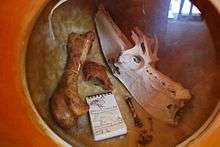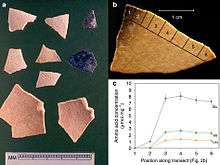Giant malleefowl
Progura is an extinct genus of megapode that was native to Australia. It was described from Plio-Pleistocene deposits at the Darling Downs and Chinchilla in south-east Queensland by Charles De Vis.
| Progura | |
|---|---|
 | |
| Fossil remains from the Naracoote Caves | |
| Scientific classification | |
| Kingdom: | |
| Phylum: | |
| Class: | |
| Order: | |
| Family: | |
| Genus: | †Progura (De Vis, 1888) |
| Species | |
| |
Taxonomy

Comparison of Australian megapodes showed that Progura was closely related to the living malleefowl (Leipoa ocellata), though the fossil species L. gallinacea was considerably larger than the living one. A second species, P. naracoortensis, was described in 1974 by van Tets from deposits in the Naracoorte Caves of south-eastern South Australia with differing size and leg proportions. It was formerly considered a synonym of L. gallinacea, on the grounds of sexual dimorphism.[1] However in a 2017 review of Cenozoic megapodes, P. naracoortensis was found to be distinct from P. gallinacea and therefore reassigned to the genus Latagallina [2] In the 2017 review, a new species, Progura campestris was created for Pleistocene material from the Nullarbor Plain.
Description
Its weight was estimated by van Tets to vary from 4–7 kg (8-15 lb). The proportions of the long bones were similar to, though larger and more robust than, those of the malleefowl, and it had a relatively broader bill, head and body. The deep keel on the sternum indicates that it was capable of flight.[3]
Eggs
Eggs previously assigned to Genyornis are now considered to have belonged to the giant malleefowl.[4] Therefore, data on dromornithid diet and chronology can actually be ascribed to this bird, instead.[5] It is believed that P. gallinacea buried its eggs in warm sand or soil.[6]
References
- Boles, W.E. (2008). "Systematics of the fossil Australian giant megapodes Progura (Aves: Megapodiidae)". Oryctos. 7: 195–295.
- Elen shute; Gavin J.Prideaux; Trevor H.Worthy (2017). "Taxonomic review of the late Cenozoic megapodes (Galliformes: Megapodiidae) of Australia". Royal Society Opening Science.
- Rich, P.V.; van Tets, G.F.; Knight, F., eds. (1985). Kadimakara: Extinct Vertebrates of Australia. Melbourne: Pioneer Design Studio. pp. 195–199. ISBN 0-909674-26-4.
- Grellet-Tinner, Gerald; Spooner, Nigel A.; Worthy, Trevor H. (February 2016). "Is the Genyornis egg of a mihirung or another extinct bird from the Australian dreamtime?". Quaternary Science Reviews. 133: 147–164. doi:10.1016/j.quascirev.2015.12.011. hdl:2328/35952.
- A case of mistaken identity for Australia’s extinct big bird
- "Ancient bird like 'a kangaroo-sized flying turkey'". BBC News. 2017-06-14. Retrieved 2017-06-15.
Further reading
- Dekker, René W. R. J. (2007). "Distribution and Speciation of Megapodes (Megapodiidae) and Subsequent Development of their Breeding". Topics in Geobiology. 29: 93–102. doi:10.1007/978-1-4020-6374-9_3. ISSN 0275-0120.
- Worthy, T. H. (2000). "The fossil megapodes (Aves: Megapodiidae) of Fiji with descriptions of a new genus and two new species". Journal of the Royal Society of New Zealand. 30 (4): 337–364. doi:10.1080/03014223.2000.9517627. ISSN 0303-6758.